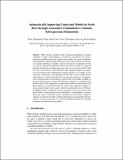Files in this item
Automatically improving constraint models in Savile Row through associative-commutative common subexpression elimination
Item metadata
| dc.contributor.author | Nightingale, Peter | |
| dc.contributor.author | Akgun, Ozgur | |
| dc.contributor.author | Gent, Ian P. | |
| dc.contributor.author | Jefferson, Christopher | |
| dc.contributor.author | Miguel, Ian | |
| dc.contributor.editor | O'Sullivan, Barry | |
| dc.date.accessioned | 2019-03-27T12:30:07Z | |
| dc.date.available | 2019-03-27T12:30:07Z | |
| dc.date.issued | 2014-09-08 | |
| dc.identifier | 160060146 | |
| dc.identifier | 4d61e32b-3892-47fe-8490-54856b224aa1 | |
| dc.identifier | 000345088200043 | |
| dc.identifier | 84906240678 | |
| dc.identifier.citation | Nightingale , P , Akgun , O , Gent , I P , Jefferson , C & Miguel , I 2014 , Automatically improving constraint models in Savile Row through associative-commutative common subexpression elimination . in B O'Sullivan (ed.) , Principles and Practice of Constraint Programming : 20th International Conference, CP 2014, Lyon, France, September 8-12, 2014. Proceedings . Lecture Notes in Computer Science , vol. 8656 LNCS , Springer , Cham , pp. 590-605 , 20th International Conference on the Principles and Practice of Constraint Programming (CP 2014) , Lyon , France , 8/09/14 . https://doi.org/10.1007/978-3-319-10428-7_43 | en |
| dc.identifier.citation | conference | en |
| dc.identifier.isbn | 9783319104270 | |
| dc.identifier.isbn | 9783319104287 | |
| dc.identifier.issn | 0302-9743 | |
| dc.identifier.other | ORCID: /0000-0002-5052-8634/work/34029953 | |
| dc.identifier.other | ORCID: /0000-0001-9519-938X/work/33210110 | |
| dc.identifier.other | ORCID: /0000-0003-2979-5989/work/60887569 | |
| dc.identifier.other | ORCID: /0000-0002-6930-2686/work/68281461 | |
| dc.identifier.uri | https://hdl.handle.net/10023/17388 | |
| dc.description | We would like to thank the Royal Society for funding through Dr Jefferson’s URF, and the EPSRC for funding this work through grant EP/H004092/1. | en |
| dc.description.abstract | When solving a problem using constraint programming, constraint modelling is widely acknowledged as an important and difficult task. Even a constraint modelling expert may explore many models and spend considerable time modelling a single problem. Therefore any automated assistance in the area of constraint modelling is valuable. Common sub-expression elimination (CSE) is a type of constraint reformulation that has proved to be useful on a range of problems. In this paper we demonstrate the value of an extension of CSE called Associative-Commutative CSE (AC-CSE). This technique exploits the properties of associativity and commutativity of binary operators, for example in sum constraints. We present a new algorithm, X-CSE, that is able to choose from a larger palette of common subexpressions than previous approaches. We demonstrate substantial gains in performance using X-CSE. For example on BIBD we observed speed increases of more than 20 times compared to a standard model and that using X-CSE outperforms a sophisticated model from the literature. For Killer Sudoku we found that X-CSE can render some apparently difficult instances almost trivial to solve, and we observe speed increases up to 350 times. For BIBD and Killer Sudoku the common subexpressions are not present in the initial model: an important part of our methodology is reformulations at the preprocessing stage, to create the common subexpressions for X-CSE to exploit. In summary we show that X-CSE, combined with preprocessing and other reformulations, is a powerful technique for automated modelling of problems containing associative and commutative constraints. | |
| dc.format.extent | 16 | |
| dc.format.extent | 282633 | |
| dc.language.iso | eng | |
| dc.publisher | Springer | |
| dc.relation.ispartof | Principles and Practice of Constraint Programming | en |
| dc.relation.ispartofseries | Lecture Notes in Computer Science | en |
| dc.subject | Symmetry | en |
| dc.subject | Breaking | en |
| dc.subject | System | en |
| dc.subject | QA75 Electronic computers. Computer science | en |
| dc.subject | BDC | en |
| dc.subject.lcc | QA75 | en |
| dc.title | Automatically improving constraint models in Savile Row through associative-commutative common subexpression elimination | en |
| dc.type | Conference item | en |
| dc.contributor.sponsor | EPSRC | en |
| dc.contributor.sponsor | EPSRC | en |
| dc.contributor.institution | University of St Andrews. School of Computer Science | en |
| dc.contributor.institution | University of St Andrews. Centre for Interdisciplinary Research in Computational Algebra | en |
| dc.identifier.doi | 10.1007/978-3-319-10428-7_43 | |
| dc.identifier.grantnumber | EP/H004092/1 | en |
| dc.identifier.grantnumber | EP/K015745/1 | en |
This item appears in the following Collection(s)
Items in the St Andrews Research Repository are protected by copyright, with all rights reserved, unless otherwise indicated.

